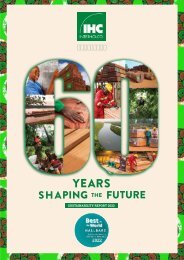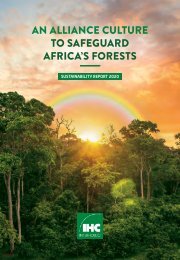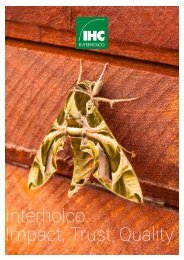Nomenclature Générale des Bois Tropicaux - 7ème édition
(english description below) Cette nomenclature est utilisée pour la mise à jour du 'Harmonized Code System' de l’Organisation Mondiale des Douanes. Dans la circulaire du 5 avril 2005, le Ministère de l’Economie, des Finances et de l’Industrie (France) reconnaît l’ATIBT comme « gardien du temple » de la nomenclature des bois tropicaux. La Commission Européenne mentionne la nomenclature de l’ATIBT comme document de référence pour la mise en œuvre du RBUE. Depuis 1954, l’ATIBT a établi et mis à jour une nomenclature des bois tropicaux faisant correspondre chaque espèce botanique avec un nom pilote reconnu internationalement. La détermination du nom pilote d’une essence est cruciale, car sa commercialisation dépend très largement de l’adoption de ce nom par le public. Le nom pilote assure la protection de l’appellation commerciale de l’essence et l’intégrité des propriétés qui lui sont attribuées, sans risque de confusion. The 1982 version of the general timber nomenclature has finally been updated as some of the 1,750 identified species, are no longer traded, while others, which were not previously included, are now on the market. The present revision has also integrated changes related to new taxonomy, in order to reflect the latest scientific developments. This Nomenclature has been used for the Harmonized Code System, updated by the World Customs Organization. The French Ministry of economy, finance and industry has given official recognition to ATIBT as the reference for the tropical timber nomenclature (NOR: PRMX0508285C of April 5th 2005). The European Commission refers to ATIBT nomenclature as a reference document for the implementation of the EUTR regulation. Since 1954, ATIBT has established and updated a nomenclature of tropical wood, linking each botanical species with an internationally recognized pilot name. A sigle wood species may have many common names; when trading across different countries, this may lead to confusion. Fixing the pilot name of a timber species is crucial, to protect the commercial denomination of the species and guarantee the veracity of the properties linked to that species, without confusion.
(english description below)
Cette nomenclature est utilisée pour la mise à jour du 'Harmonized Code System' de l’Organisation Mondiale des Douanes. Dans la circulaire du 5 avril 2005, le Ministère de l’Economie, des Finances et de l’Industrie (France) reconnaît l’ATIBT comme « gardien du temple » de la nomenclature des bois tropicaux. La Commission Européenne mentionne la nomenclature de l’ATIBT comme document de référence pour la mise en œuvre du RBUE.
Depuis 1954, l’ATIBT a établi et mis à jour une nomenclature des bois tropicaux faisant correspondre chaque espèce botanique avec un nom pilote reconnu internationalement. La détermination du nom pilote d’une essence est cruciale, car sa commercialisation dépend très largement de l’adoption de ce nom par le public. Le nom pilote assure la protection de l’appellation commerciale de l’essence et l’intégrité des propriétés qui lui sont attribuées, sans risque de confusion.
The 1982 version of the general timber nomenclature has finally been updated as some of the 1,750 identified species, are no longer traded, while others, which were not previously included, are now on the market. The present revision has also integrated changes related to new taxonomy, in order to reflect the latest scientific developments.
This Nomenclature has been used for the Harmonized Code System, updated by the World Customs Organization. The French Ministry of economy, finance and industry has given official recognition to ATIBT as the reference for the tropical timber nomenclature (NOR: PRMX0508285C of April 5th 2005). The European Commission refers to ATIBT nomenclature as a reference document for the implementation of the EUTR regulation.
Since 1954, ATIBT has established and updated a nomenclature of tropical wood, linking each botanical species with an internationally recognized pilot name. A sigle wood species may have many common names; when trading across different countries, this may lead to confusion. Fixing the pilot name of a timber species is crucial, to protect the commercial denomination of the species and guarantee the veracity of the properties linked to that species, without confusion.
Create successful ePaper yourself
Turn your PDF publications into a flip-book with our unique Google optimized e-Paper software.
Liste des noms pilotes des bois tropicaux avec renvoi aux noms scientifiques /// 61
PILOT NAME BOTANICAL NAMES COMMON NAMES
Ebène de Madagascar
Ebène noire d’Asie
Ebène veinée d’Asie
Ebiara
Ekaba
Ekoune
Emien
Diospyros gracilipes Hiern *
Diospyros hazomainty H. Perrier *
Diospyros perrieri H. Jum. *
Diospyros toxicaria Hiern *
Diospyros p.p. *
Diospyros ebenum Koen.
Diospyros melanoxylon Roxb.
Diospyros mollis Griff.
Diospyros mun H. Lec.
Diospyros vera A. Chev. *
(Syn. Diospyros ferrea)
Diospyros p.p.
Diospyros celebica Bakh.
Diospyros marmorata Roxb.
Diospyros rumphii Bakh.
Diospyros p.p.
Berlinia bracteosa Benth.
Berlinia confusa Hoyle
Berlinia grandiflora Hutch. & Dalziel
Berlinia spp.
Tetraberlinia bifoliolata Hauman
(Syn. Berlinia bifoliolata)
Tetraberlinia longiracemosa Wieringa
Tetraberlinia tubmaniana J. Léonard
Tetraberlinia spp.
Coelocaryon botryoides Vermoesen
Coelocaryon preussii Warb.
Alstonia boonei De Wild.
Alstonia congensis Engl.
(Syn. Alstonia gilletii)
Ebène de Madagascar (MG) ; Hazomainty (MG)
Black Ebony (IN) ; Ceylon Ebony (LK) ; Ebony (IN) ;
Kaju Hitam (ID) ; Ma Klua (TH) ; Mun (VN)
Ebony (ID) ; Kaju Hitam (ID) ; Macassar Ebony
(MY) ; Marblewood (IN)
Abem (CM) ; Bagbe (BJ) ; Berlinia (GH) ; Ebiara
(GA) ; Ekpogoi (NG) ; Essabem (CM) ; Melegba
(CI) ; M’Possa (AO, CD, CG) ; Pocouli (CI) ; Sarkpei
(SL)
Eko-Andoung (CG, GA) ; Ekop (GQ) ; Ekop-Ribi
(CM) ; Hoh (LR) ; Sikon (LR)
Espina de corona Gleditsia amorphoides Taub. Espina de corona (BR, PY)
Essessang
Essia
Etimoé
Eveuss
Evino
Ricinodendron heudelotii Pierre
(Syn. Ricinodendron africanum)
Schinziophyton rautanenii Schinz
(Syn. Ricinodendron rautanenii)
Petersianthus macrocarpus Liben
(Syn. Combretodendron africanum)
(Syn. Petersia africana)
Copaifera mildbraedii Harms
Copaifera salikounda Heckel
Copaifera p.p.
Klainedoxa gabonensis Pierre
Klainedoxa trillesii Pierre
Vitex ciliata Pellegr.
Vitex doniana Sweet
(Syn. Vitex pachyphylla)
Vitex micrantha Gürke
Vitex spp. (AF)
Egbenrin (NG) ; Ekoune (GA, GQ) ; Ekun (GQ) ;
Kikubi-Lomba (CG) ; Kolomeko (CF) ; Lomba-Kumbi
(CD) ; Nom Eteng (CM)
Abale (CI) ; Afatin (BJ) ; Ahun (NG) ; Akuka (CD) ;
Awun (NG) ; Ekouk (CM, GA, GQ) ; Ekuk (CM,
GA, GQ) ; Emien (CI) ; Kaiwi (SL) ; Mogouga (CF) ;
Mujwa (UG) ; Sindru (GH) ; Sinduro (GH) ; Tsongoti
(CG)
Eho (CI) ; Erimado (NG, TG) ; Essessang (CM) ;
Muawa (BJ, MZ) ; Sanga-Sanga (CG) ; Wama (GH)
Abalé (CI) ; Abing (CM, GA) ; Bossoho (CD) ; Esia
(GH) ; Essia (GH) ; Minzu (CG) ; Nossoba (CF) ;
Owewe (NG) ; Wulo (CD)
Akpaflo (BJ) ; Andem-Evine (GA) ; Anzèm noir
(GA) ; Bilombi (CF) ; Bofelele (CD) ; Entedua (GH) ;
Essak (CM) ; Etimoé (CI) ; Ovbialeke (NG) ; Yama
(CF, CG)
Eves (GA, GQ) ; Eveuss (GA, GQ) ; Ikele (CD) ;
Kroma (CI) ; Kruma (GH) ; Kuma-Kuma (CD, CG) ;
Ngon (CM) ; Oboro (CF) ; Odudu (NG)
Angona (GA) ; Evino (GA) ; N’To (GA) ; Vindou
(CG)














